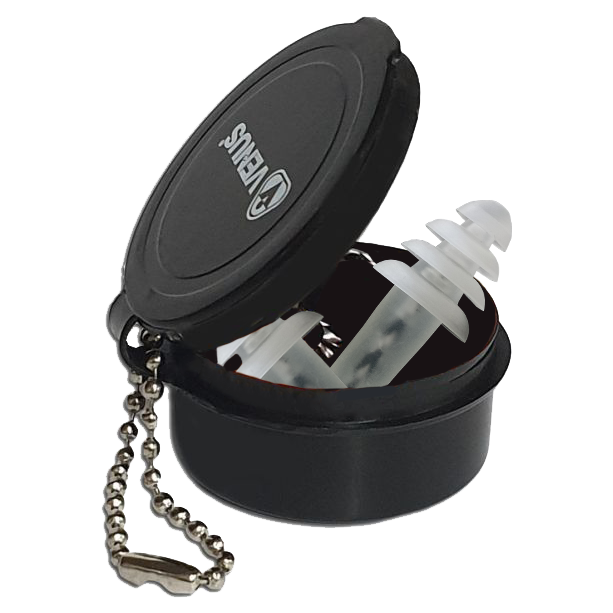Signs Your Workplace Might Be Too Loud
 August 11, 2025
10343
August 11, 2025
10343

Do you sometimes feel that your workplace might be a little too noisy? You’re probably right to be concerned. The Centers for Disease Control (CDC) estimates that 22 million workers are exposed to potentially damaging noise at work each year, making workplace hearing protection one of the most critical yet often overlooked aspects of occupational safety. However, by the time you realize there’s a problem, permanent damage might already be done.
Most people are unaware of how stealthy noise-induced hearing loss can be. Unlike a sudden injury, it develops gradually, and many workers don’t notice the early warning signs until significant damage has already occurred. Understanding the safety workplace signs that indicate excessive noise exposure can save your hearing and your employer’s bottom line.
The Numbers Don’t Lie: When Workplace Noise Becomes Dangerous
Before exploring the warning signs, it’s essential to understand what constitutes safe noise levels at work. According to OSHA standards, the permissible exposure limit (PEL) for workplace noise is 90 decibels (dBA) as an eight-hour time-weighted average. However, NIOSH recommends a more conservative 85 dBA limit, recognizing that even OSHA’s standard may not prevent all hearing loss.
To put these workplace noise levels into perspective, everyday conversations typically register around 60 dBA, while a lawnmower operates at approximately 90 dBA. Once you hit 100 dBA, roughly equivalent to a motorcycle, you’re looking at potential hearing damage with just 15 minutes of exposure. At 110 dBA, which is common in many manufacturing environments, damage can occur in less than two minutes.
Different industries present varying levels of risk for hearing damage in the workplace. Research from the Indian steel industry reveals particularly alarming statistics, with more than 90% of workers showing significant hearing loss at medium and high frequencies. This study highlights how specific industrial environments can be especially hazardous to workplace hearing.
Physical Signs That Noise Levels Are Too High
Your body often provides the first clues that your workplace hearing is at risk. The most obvious indicator is temporary hearing loss or a “stuffed-up” feeling in your ears after work. If you find yourself struggling to hear conversations or the television seems quieter when you get home, that’s your ears telling you that they’ve been overworked.
Tinnitus, a persistent ringing, buzzing, or humming in your ears, is another red flag that shouldn’t be ignored. While it may start as a temporary annoyance after a particularly loud day, repeated exposure can make it a permanent issue. Many workers dismiss this early warning sign, assuming it’s just part of the job. It’s not, and it doesn’t have to be.
Physical fatigue and headaches are also common symptoms of excessive noise exposure, often associated with workplace hearing issues. When your auditory system is constantly working overtime to process loud sounds, it creates stress throughout your entire nervous system. You might find yourself more tired than usual after work, even if the job isn’t physically demanding.

Behavioral Indicators in Your Workplace
Sometimes the signs aren’t about what you’re experiencing personally, but what you’re observing in your work environment. If colleagues frequently need to raise their voices to communicate during everyday work activities, that’s a clear indication that workplace noise levels exceed safe limits.
Watch how people behave around specific equipment or work areas. Do workers instinctively cover their ears when specific machines are used? Do people avoid spending time in particular areas unless necessary? These natural reactions often indicate that noise levels in those areas are uncomfortably high and potentially hazardous.
Another tell-tale sign is when workers develop informal communication systems to avoid verbal communication. Hand signals, written notes, or waiting until machines are shut off to have conversations all suggest that ambient noise levels interfere with normal communication patterns.
The Communication Test: A Simple Workplace Assessment
Here’s a practical way to assess whether your workplace might be too loud: try the three-foot rule. If you need to raise your voice to speak with someone three feet away, you’re likely dealing with noise levels that exceed safe limits for extended exposure. This simple test doesn’t require expensive equipment or specialized training; it just requires basic awareness of how hard you’re working to communicate.
Similarly, if you find yourself reading lips more than listening during conversations, or if you frequently ask people to repeat themselves during the workday, these could be early indicators that workplace hearing is being compromised by excessive noise exposure.
The phone test is another useful indicator. If taking phone calls becomes difficult in your normal work area, not because of a bad connection, but because you can’t hear over the background noise, then that’s a sign that noise levels at your workplace are problematic.
Technology and Equipment Warning Signs
Your equipment itself often provides clues about noise levels. If machines vibrate excessively, produce high-pitched whines, or have worn parts that create additional noise, these mechanical issues typically correlate with increased sound output, which can affect workplace hearing.
Pay attention to how often equipment needs maintenance or replacement. Excessive noise usually indicates mechanical problems that not only create hearing hazards but also suggest equipment inefficiency and potential safety risks. Addressing these issues simultaneously improves both noise control and operational efficiency.
Check whether newer equipment operates more quietly than older models. This comparison can help identify specific noise sources and prioritize equipment upgrades that improve both productivity and workplace hearing protection.

Environmental Clues You Shouldn’t Ignore
The physical workspace itself provides vital safety signs about noise levels. Hard surfaces, such as concrete floors, metal walls, and high ceilings, amplify and reflect sound, potentially creating hazardous noise levels even when individual machines aren’t deafening.
Observe whether sound seems to echo or reverberate in your workspace. This acoustic characteristic often indicates that environmental modifications such as the use of sound-absorbing materials may be necessary to maintain safe noise levels in the workplace.
Multiple noise sources operating simultaneously create cumulative effects that can push workplace noise levels well beyond safe limits, even when individual sources seem manageable. If your workspace has numerous machines, vehicles, or other noise-generating equipment operating concurrently, the combined effect often exceeds what any single source would produce.
Taking Action: What Happens Next
Recognizing these warning signs is just the first step. OSHA requires employers to implement hearing conservation programs when workers are exposed to noise levels at or above 85 dBA over an eight-hour workday. These programs must include noise monitoring, audiometric testing, hearing protection, training, and program evaluation.
If you’ve identified potential problems, document your observations and discuss them with your supervisor or safety coordinator. Many employers are unaware of the gradual changes in workplace noise levels that occur when equipment ages or work processes evolve.
Remember that workplace hearing protection isn’t just about compliance, it’s about preserving one of your most valuable senses for life. Unlike many workplace injuries, noise-induced hearing loss is permanent. Surgery can’t fix it, and while hearing aids are helpful, they can’t restore natural hearing.
The good news is that noise-induced hearing loss is entirely preventable with proper precautions. By recognizing the warning signs early and taking appropriate action, you can protect your hearing while maintaining productivity and job satisfaction at your workplace.
Don’t wait until the damage is done. If your workplace exhibits any of these signs, it’s time to take action and implement safety measures that advocate for proper hearing protection.


